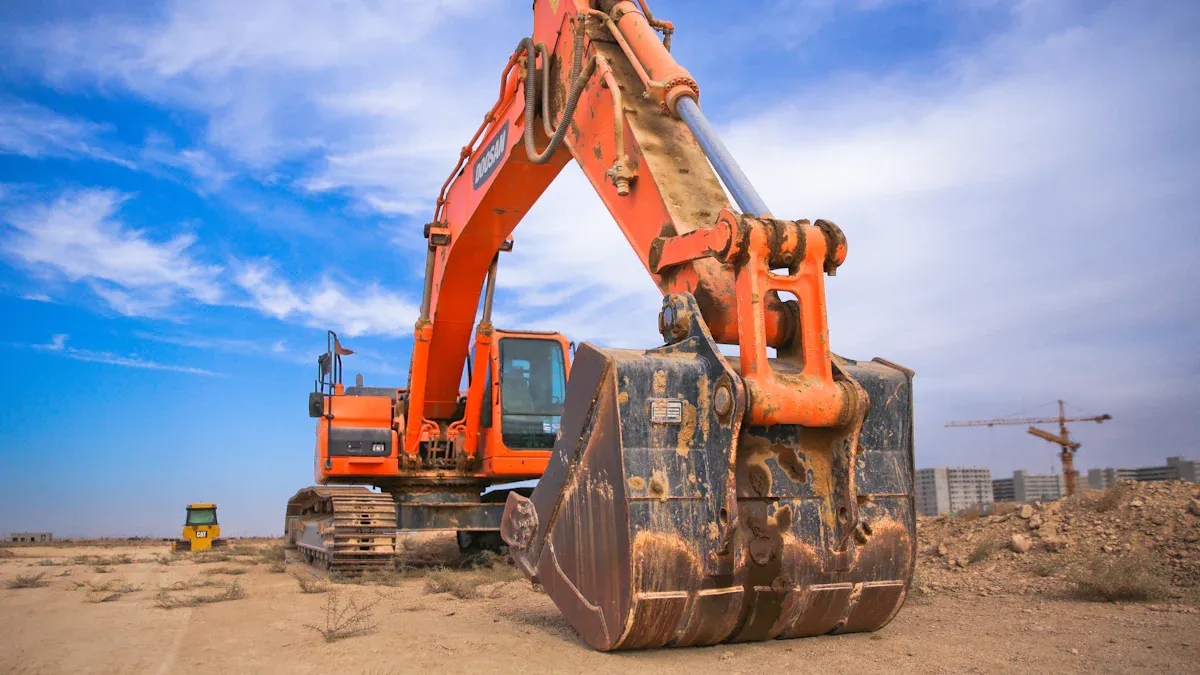
The low-altitude economy focuses on activities within the airspace below 1,000 feet, including drones, eVTOL vehicles, and urban air mobility systems. Its importance grows as industries like logistics and public safety adopt these technologies. Artificial intelligence drives this transformation by optimizing operations and unlocking new possibilities. For example, China's low-altitude economy could contribute up to 2 trillion yuan to its GDP by 2030, with over 14,000 companies already licensed for drone operations. AI-powered tools also improve efficiency, such as UPS's routing software saving 10 million gallons of fuel annually.
Key Takeaways
-
AI helps businesses work better by automating jobs. This lets workers focus on important tasks.
-
AI uses live data to predict repairs and improve flights. This saves companies a lot of money.
-
Drones with AI plan smart routes for deliveries. This makes shipping quicker and cheaper.
AI's Transformative Role in the Low-Altitude Economy

Enhancing Operational Efficiency
In the low-altitude economy, efficiency is the cornerstone of success. AI-powered drones and eVTOLs (electric vertical takeoff and landing vehicles) are revolutionizing operations by automating repetitive tasks and streamlining workflows. For example, AI systems can inspect products with 99.9% accuracy, outperforming human inspectors and reducing waste. This level of precision ensures that resources are used effectively, minimizing errors and maximizing output.
AI also enhances productivity by allowing employees to focus on strategic tasks rather than mundane activities. For instance, JPMorgan implemented AI to reduce document review time from 360,000 hours to mere seconds. This kind of transformation not only saves time but also cuts costs significantly. Predictive analytics further optimize resource allocation, preventing shortages and over-provisioning, which are common challenges in industries relying on low-altitude flight operations.
|
Metric |
الوصف |
|---|---|
|
Productivity |
AI-driven automation enhances human potential by allowing employees to focus on strategic tasks. |
|
Cost Reduction |
Automation of repetitive tasks leads to significant savings in operational costs. |
|
Decision-Making |
Faster decision cycles are achieved through AI, reducing operational friction. |
|
Quality Control |
AI systems inspect products with 99.9% accuracy, significantly better than human inspectors. |
|
Time Efficiency |
AI reduced document review time from 360,000 hours to seconds at JPMorgan. |
|
Resource Management |
Predictive analytics optimize resource allocation, preventing shortages and over-provisioning. |
By leveraging AI, you can achieve unparalleled operational efficiency, positioning your business to thrive in the competitive low-altitude economy.
Real-Time Data Analytics and Predictive Insights
AI excels at turning raw data into actionable insights, a critical capability in the fast-paced world of advanced air mobility (AAM). Real-time data analytics enable you to monitor low-altitude flight operations continuously, ensuring safety and efficiency. For example, AI systems achieve a prediction accuracy of 95%, reducing unscheduled maintenance events by 42%. This translates to annual cost savings exceeding $12 million for organizations that adopt these technologies.
|
Metric |
1TP15التالي |
|---|---|
|
Prediction Accuracy |
95% |
|
Reduction in Unscheduled Maintenance Events |
42% |
|
Annual Cost Savings |
Exceeding $12 million |
AI-powered drones also play a pivotal role in urban air mobility by customizing routes in real time. This capability enhances passenger experience and ensures timely deliveries. Additionally, regulatory frameworks are evolving to incorporate AI, fostering innovation while maintaining safety and compliance. By embracing these advancements, you can stay ahead of the curve in the rapidly evolving low-altitude economy.
Automating Complex Processes
Automation is a game-changer in the low-altitude economy, especially for processes that are traditionally time-consuming and error-prone. AI-powered drones and eVTOLs excel at handling complex tasks like infrastructure inspections, package delivery, and air taxi services. For instance, AI has reduced invoice processing times from 10 days to just 2 days, significantly improving throughput and capacity.
|
Performance Indicator |
الوصف |
|---|---|
|
Process Cycle Time |
Reduction in time taken to complete a process, e.g., invoice processing from 10 days to 2 days. |
|
Throughput/Capacity |
Increase in the number of transactions handled, e.g., support team handling 150 tickets instead of 100. |
|
Error Rate/Quality |
Improvement in error rates, e.g., order entry errors dropping from 5% to 0.5%. |
|
Cost Per Transaction |
Decrease in processing costs, e.g., customer inquiries costing $5 reduced to a few cents. |
AI-powered quality control systems also prevent costly recalls by identifying defects early in the production process. In drone delivery applications, AI ensures packages reach their destinations efficiently, reducing delays and enhancing customer satisfaction. By automating these processes, you can scale your operations without compromising on quality or reliability.
Applications of AI in the Low-Altitude Economy
Urban Air Mobility and Passenger Transport
AI is revolutionizing urban air mobility by making passenger transport safer, faster, and more efficient. AI-equipped unmanned vehicles significantly reduce human-caused accidents by processing real-time data and making split-second decisions. These systems also enhance traffic flow and reduce congestion by coordinating with infrastructure and other vehicles. This creates smoother traffic patterns and promotes environmental sustainability.
The urban air mobility market is projected to reach $15.6 billion by 2033, growing at a compound annual growth rate (CAGR) of 11.19%. This growth stems from advancements in battery technology, autonomous systems, and the increasing demand for sustainable transportation. Passenger air taxis, logistics, and emergency services are among the key sectors benefiting from this expansion. Smart cities further facilitate the integration of urban air mobility with existing transportation networks, making it a cornerstone of the low-altitude economy.
AI-Powered Drones for Logistics and Delivery
AI-powered drones are transforming logistics and delivery operations by optimizing routes, improving efficiency, and ensuring timely deliveries. These drones use advanced algorithms to autonomously plan flight paths, taking into account weather, airspace, and traffic data. Real-time adjustments based on weather conditions reduce delays and enhance reliability. For example, DHL reported a 15% increase in on-time deliveries and a 20% reduction in shipment delays due to AI route planning.
AI also enhances energy efficiency by optimizing battery usage and selecting energy-efficient routes. This is particularly crucial for sensitive deliveries, such as medical supplies, where stability and precision are paramount. Amazon has leveraged AI to achieve a 30% increase in delivery speed, demonstrating the transformative potential of this technology. AI-powered drones not only improve operational efficiency but also set new standards for customer satisfaction in the low-altitude economy.
Public Safety and Emergency Response
AI plays a critical role in public safety and emergency response by enabling faster and more effective interventions. In Los Angeles, real-time threat detection systems have reduced response times by 40%, enhancing urban security and law enforcement efficiency. Automated emergency dispatch systems, like those in New York City, minimize human error and improve reliability, ensuring quicker assistance during crises.
Multilingual emergency message systems powered by AI have improved public comprehension by 65%, leading to a 70% increase in effective responses to alerts. Drones equipped with AI can assess disaster zones, detect hazards like gas leaks, and provide real-time data to emergency teams. These capabilities make AI an indispensable tool for safeguarding communities and responding to emergencies in the low-altitude economy.
|
AI Implementation |
Impact on Response Times |
Improvement in Effectiveness |
|---|---|---|
|
Real-time threat detection in Los Angeles |
Enhanced urban security and quicker law enforcement response |
|
|
Automated Emergency Dispatch System in NYC |
Faster dispatch |
Reduced human error and improved reliability |
|
Multilingual emergency message system |
65% improvement in comprehension |
70% improvement in public response to alerts |
Infrastructure Monitoring and Maintenance
AI-powered drones excel in infrastructure monitoring and maintenance by conducting inspections, detecting hazards, and enabling predictive maintenance. These drones can quickly identify structural issues like cracks or leaks, significantly reducing inspection times. Predictive maintenance systems use AI to forecast potential failures, allowing you to prioritize urgent repairs and minimize risks.
Drones also enhance emergency response by detecting hazards such as gas leaks or structural risks. They can autonomously patrol properties, improving security and surveillance. For example, drones can assess damage after disasters, enabling faster recovery efforts. AI-driven pest control monitoring identifies breeding zones and moisture build-up, optimizing pest control strategies. These applications highlight the versatility of AI-powered drones in maintaining infrastructure and ensuring safety in the low-altitude economy.
Technological Innovations in the Low-Altitude Economy

Advancements in AI-Powered Drones
AI-powered drones are redefining the low-altitude economy by combining advanced algorithms with cutting-edge hardware. These drones excel in autonomous learning, allowing them to adapt to new environments without prior mapping. This capability enhances their operational flexibility, making them ideal for tasks like infrastructure monitoring and disaster response. Real-time data processing enables drones to analyze environmental changes instantly, improving decision-making and navigation.
Swarm intelligence is another breakthrough. It allows multiple drones to coordinate seamlessly, completing complex tasks with minimal human oversight. For example, drones equipped with real-time model adaptation can continuously learn from field data, improving object recognition and obstacle avoidance. These advancements not only boost efficiency but also set new benchmarks for reliability in low-altitude operations.
|
Performance Metric |
الوصف |
|---|---|
|
Autonomous Learning |
Drones can adapt to new environments without prior mapping. |
|
Real-Time Data Processing |
Instant analysis of environmental changes improves decision-making. |
|
Multi-Agent Coordination |
Swarm intelligence enables collaborative task completion. |
|
Real-Time Model Adaptation |
Continuous learning enhances object recognition and obstacle avoidance. |
eVTOL Technologies and AI Integration
eVTOLs are transforming urban air mobility by integrating AI for enhanced performance and safety. AI-driven algorithms enable autonomous flight systems, allowing eVTOLs to navigate crowded airspace with precision. Real-time decision-making ensures obstacle avoidance and smooth navigation, even in challenging conditions. Predictive maintenance, powered by AI, reduces downtime by identifying potential issues before they escalate.
The market for eVTOLs is projected to grow from $1.7 billion in 2023 to $39 billion by 2033, with a compound annual growth rate of 36.8%. This rapid expansion highlights the increasing demand for sustainable and efficient transportation solutions. Machine learning models optimize eVTOL performance, while intelligent air traffic management systems ensure safe and efficient operations in low-altitude airspace.
|
Year |
Market Value (USD Billion) |
CAGR (%) |
|---|---|---|
|
2023 |
1.7 |
N/A |
|
2033 |
39.0 |
36.8 |
AI and IoT for Intelligent Transportation Systems
The integration of AI and IoT is revolutionizing intelligent transportation systems within the low-altitude economy. Intelligent air traffic control systems, powered by AI, ensure full-area communication and efficient dispatch. These systems use metaheuristic and machine learning algorithms to resolve overload instances and minimize conflicts in low-altitude airspace.
IoT sensors, combined with AI, enable real-time monitoring of UAVs and eVTOLs. This ensures optimal performance and enhances safety. High-energy-density battery technology further supports these advancements by extending the endurance of electrified aircraft. Together, AI and IoT create a seamless ecosystem that supports the growing demands of urban air mobility and logistics.
|
Aspect |
Details |
|---|---|
|
Focus |
Development of an intelligent Uncrewed Aircraft Traffic Management (UTM) system |
|
Methodology |
Utilizes metaheuristic and machine learning algorithms |
|
Key Findings |
Resolves overload instances and minimizes potential conflicts in low-altitude airspace |
|
Operational Efficiency |
Achieves operationally acceptable running time for UAM services |
🚀 Tip: By embracing these innovations, you can position yourself at the forefront of the low-altitude economy, leveraging AI and IoT to unlock new opportunities.
Market Trends and Global Developments
Investment Patterns in AI and Low-Altitude Technologies
The low-altitude economy is experiencing a surge in investments, driven by advancements in AI and related technologies. These investments are reshaping industries like logistics, urban air mobility, and infrastructure monitoring. For instance, AI is transforming space technology by enabling autonomous satellite operations and real-time Earth monitoring. It also plays a pivotal role in predicting natural disasters and optimizing telecommunications networks.
In addition, additive manufacturing is revolutionizing the aerospace sector. The integration of AI and machine learning into satellite systems enhances operational efficiency, further fueling market growth. These technological advancements are expected to drive significant expansion in the global market, creating opportunities for businesses to innovate and scale.
Regulatory Frameworks and Standards
Regulatory frameworks are evolving to support the integration of AI within the low-altitude economy. Cities like Shanghai are leading the way by developing comprehensive supply chains for low-altitude aircraft. This includes design, manufacturing, and operational services, with over 100 applications in urban transport and logistics. To support this growth, Shanghai is building innovation hubs and essential ground-service infrastructure, enabling the expansion of low-altitude flight routes.
AI, big data, and advanced communication technologies are also being integrated into air traffic regulation. These tools enhance flight operations and ensure the safe deployment of eVTOLs. Such regulatory advancements create a stable environment for businesses to adopt AI-driven solutions confidently.
Global Competition and Regional Leadership
The global race for leadership in AI-driven low-altitude technologies is intensifying. The USA is projected to dominate the drone market, with an estimated value of $58.4 billion by 2026. This leadership stems from Silicon Valley's technological innovations and strategic investments by the Pentagon. The FAA's Remote ID requirements and the BEYOND program have further solidified the regulatory landscape, benefiting sectors like energy infrastructure inspection.
Meanwhile, China excels in hardware manufacturing, with DJI controlling about 70% of the consumer drone market. This highlights a clear divide in strengths: the USA leads in software and data analytics, while China dominates hardware production. These contrasting capabilities underscore the competitive dynamics shaping the low-altitude economy.
Opportunities and Challenges in the Low-Altitude Economy
Addressing Regulatory and Safety Concerns
Regulatory and safety concerns remain significant challenges in the low-altitude economy. As you adopt AI-driven technologies like drones and eVTOLs, compliance with evolving regulations becomes essential. Governments worldwide are working to establish frameworks that balance innovation with public safety. For example, cities like Shanghai are building comprehensive supply chains and infrastructure to support low-altitude operations. These efforts include integrating AI and big data into air traffic management systems to ensure safe and efficient operations.
Safety concerns also extend to public acceptance. Many individuals remain skeptical about the reliability of autonomous systems. Addressing these concerns requires transparent communication and rigorous safety testing. By prioritizing safety and compliance, you can build trust and foster wider adoption of AI-powered solutions in this emerging sector.
Overcoming Technical and Scalability Barriers
Technical and scalability barriers often hinder the full potential of AI in low-altitude applications. Performance metrics like latency, throughput, and memory footprint highlight these challenges. For instance:
|
Metric |
الوصف |
|---|---|
|
Latency |
Mean latency (ms/request); Tail latency (p95, p99, p99.9) for evaluating real-time performance. |
|
Throughput |
Queries per second (QPS); Frames per second (FPS); Batch throughput for large-scale systems. |
|
Memory Footprint |
Model size (MB/GB); RAM usage (MB); Memory bandwidth utilization for edge and mobile deployments. |
Robustness is critical for maintaining quality of service in low-altitude economy networks. Many applications, such as disaster response and urban air mobility, are mission-critical. Even minor technical issues can disrupt operations. By focusing on robust design and scalable AI systems, you can overcome these barriers and ensure reliable performance.
Unlocking New Business Models and Economic Growth
The low-altitude economy offers immense opportunities for economic growth and innovation. AI enables the creation of new business models in urban air mobility, logistics, and infrastructure monitoring. For example, the urban air mobility market is projected to grow from $4.6 billion in 2024 to $23.5 billion by 2030, with a compound annual growth rate of 31.2%. Similarly, the global drone market is expected to reach $127 billion by 2030.
|
Segment |
Current Value (2024) |
Projected Value (2030) |
CAGR (%) |
|---|---|---|---|
|
Urban Air Mobility (UAM) |
USD 4.6 billion |
USD 23.5 billion |
31.2% |
|
Global Drone Market |
N/A |
USD 127 billion |
N/A |
Governments are also prioritizing this sector. In China, the National Development and Reform Commission has established a division to oversee the growth of the low-altitude economy. By leveraging AI, you can tap into these opportunities, drive innovation, and contribute to economic expansion.
AI reshapes the low-altitude economy by driving innovation across industries. You see its impact in diverse areas:
-
Drone technology creates opportunities in tourism and entertainment, such as aerial photography and performances.
-
Delivery services improve efficiency and reduce costs, with global e-commerce leaders testing drone logistics.
-
Public services benefit from drones in emergency response, urban planning, and resource allocation.
Collaboration among businesses, governments, and communities ensures these advancements address challenges and unlock growth.
التعليمات
What is the low-altitude economy?
The low-altitude economy focuses on activities within airspace below 1,000 feet, including drones, eVTOLs, and urban air mobility systems. It drives innovation in logistics, transport, and safety.
How does AI improve drone operations?
AI optimizes flight paths, enhances battery efficiency, and ensures real-time adjustments. These capabilities improve delivery speed, reduce costs, and enhance reliability in logistics and monitoring.
What industries benefit most from AI in the low-altitude economy?
Logistics, urban air mobility, public safety, and infrastructure monitoring benefit significantly. AI-powered tools improve efficiency, scalability, and innovation across these sectors.







